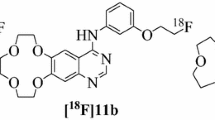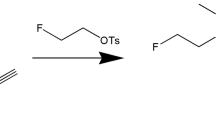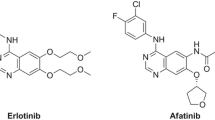Abstract
Objective
Gefitinib (N-(3-chloro-4-fluorophenyl)-7-methoxy-6-[3-(morpholin-4-yl)propoxy]quinazolin-4-amine, Iressa) is an approved anticancer drug. In this study, we labeled gefitinib with carbon-11 and evaluated [11C]gefitinib to explore its specific binding in intact fibrosarcoma (NFSa)-bearing mice.
Methods
[11C]Gefitinib was synthesized by the reaction of desmethyl precursor (1) with [11C]CH3I. In vitro uptake of [11C]gefitinib into NFSa, human-A431 epidermoid carcinoma, and Jurkat T cells was determined. Positron emission tomography (PET) imaging using [11C]gefitinib was performed for NFSa-bearing mice.
Results
[11C]Gefitinib accumulated into NFSa cells with 2.1 uptake ratio (UR)/mg protein in cells. Addition of nonradioactive gefitinib decreased uptake in a concentration-dependent manner. [11C]Gefitinib also had high uptake (2.6 UR/mg protein) into epidermal growth factor receptor/tyrosine kinase (EGFR/TK)-rich A431 cells but low uptake (0.2 UR/mg protein) into EGFR/TK-poor Jurkat cells. In vivo distribution study on NFSa-bearing mice by the dissection method revealed that [11C]gefitinib specifically accumulated into the tumor. The ratio of radioactivity in tumors to that in blood and muscle as two comparative regions increased from 0.4 to 6.0 and from 0.6 to 5.0 during this experiment (0–60 min), respectively. PET for NFSa-bearing mice produced a clear tumor image, although high radioactivity was distributed throughout the body. Treatment with nonradioactive gefitinib (100 mg/kg) decreased uptake in the tumor. In vivo metabolite analysis demonstrated that [11C]gefitinib was stable in the tumor, liver, kidney, and blood.
Conclusion
These results demonstrated the promising potential of [11C]gefitinib to serve as a PET ligand for in vivo imaging of NFSa-bearing mice.








Similar content being viewed by others
References
Khazaie K, Schirrmacher V, Lichtner RB (1993) EGF receptor in neoplasia and metastasis. Cancer Metastasis Rev 12:255–274
Voldborg BR, Damstrup L, Spang-Thomsen M, Poulsen HS (1997) Epidermal growth factor receptor (EGFR) and EGFR mutations, function and possible role in clinical trials. Ann Oncol 8:1197–1206
Boschelli DH (2002) 4-Anilino-3-quinolinecarbonitriles: an emerging class of kinase inhibitors. Curr Top Med Chem 2:1051–1063
Raymond E, Faivre S, Armand JP (2000) Epidermal growth factor receptor tyrosine kinase as a target for anticancer therapy. Drugs 60(suppl 1):15–23
Ciardiello F, Caputo R, Bianco R et al (2001) Inhibition of growth factor production and angiogenesis in human cancer cells by ZD1839 (Iressa), a selective epidermal growth factor receptor tyrosine kinase inhibitor. Clin Cancer Res 7:1459–1465
Moulder SL, Yakes FM, Muthuswamy SK, Bianco R, Simpson JF, Arteaga CL (2001) Epidermal growth factor receptor (HER1) tyrosine kinase inhibitor ZD1839 (Iressa) inhibits HER2/neu (erbB2)-overexpressing breast cancer cells in vitro and in vivo. Cancer Res 61:8887–8895
Wakeling AE, Guy SP, Woodburn JR et al (2002) ZD1839 (Iressa): an orally active inhibitor of epidermal growth factor signaling with potential for cancer therapy. Cancer Res 62:5749–5754
Anido J, Matar P, Albanell J et al (2003) ZD1839, a specific epidermal growth factor receptor (EGFR) tyrosine kinase inhibitor, induces the formation of inactive EGFR/HER2 and EGFR/HER3 heterodimers and prevents heregulin signaling in HER2-overexpressing breast cancer cells. Clin Cancer Res 9:1274–1283
Bellomi M, Petralia G, Sonzogni A, Zampino MG, Rocca A (2007) CT perfusion for the monitoring of neoadjuvant chemotherapy and radiation therapy in rectal carcinoma: initial experience. Radiology 244:486–493
Søvik A, Kippenes SH, Bruland ØS, Rune OD, Malinen E (2008) DCEMRI monitoring of canine tumors during fractionated radiotherapy. Acta Oncol 47:1249–1256
Mikhaeel NG (2006) Use of FDG-PET to monitor response to chemotherapy and radiotherapy in patients with lymphomas. Eur J Nucl Med Mol Imaging 33(Suppl 1):22–26
Molthoff CF, Klabbers BM, Berkhof J et al (2007) Monitoring response to radiotherapy in human squamous cell cancer bearing nude mice: comparison of 2′-deoxy-2′-[18F]fluoro-D-glucose (FDG) and 3′-[18F]fluoro-3′-deoxythymidine (FLT). Mol Imaging Biol 9:340–347
Van de Wiele C, Lahorte C, Oyen W et al (2003) Nuclear medicine imaging to predict response to radiotherapy: a review. Int J Radiat Oncol Biol Phys 55:5–15
Riesterer O, Milas L, Ang KK (2007) Use of molecular biomarkers for predicting the response to radiotherapy with or without chemotherapy. J Clin Oncol 25:4075–4083
Fredriksson A, Stone-Elander S (2003) PET screening of anticancer drugs. A faster route to drug/target evaluations in vivo. Methods Mol Med 85:279–294
Bading JR, Shields AF (2008) Imaging of cell proliferation: status and prospects. J Nucl Med 49(Suppl 2):64S–80S
Ishikawa H, Tsuji H, Kamada T et al (2006) Risk factors of late rectal bleeding after carbon ion therapy for prostate cancer. Int J Radiat Oncol Biol Phys 66:1084–1091
Tsuji H, Mizoe J, Kamada T et al (2007) Clinical results of carbon ion radiotherapy at NIRS. J Radiat Res 48S:A1–A13
Sugane T, Baba M, Imai R et al (2009) Carbon ion radiotherapy for elderly patients 80 years and older with stage I non-small cell lung cancer. Lung Cancer 64:45–50
Zhang H, Yoshikawa K, Tamura K et al (2004) [11C]Methionine positron emission tomography and survival in patients with bone and soft tissue sarcomas treated by carbon ion radiotherapy. Clin Cancer Res 10:1764–1772
Koizumi M, Saga T, Yoshikawa K et al (2008) 11C-Methionine-PET for evaluation of carbon ion radiotherapy in patients with pelvic recurrence of rectal cancer. Mol Imaging Biol 10:374–380
Holt DP, Ravert HT, Dannals RF, Pomper MG (2006) Synthesis of [11C]gefitinib for imaging epidermal growth factor receptor tyrosine kinase with positron emission tomography. J Labelled Comp Radiopharm 49:883–888
Wang JQ, Gao M, Miller KD, Sledge GW, Zheng QH (2006) Synthesis of [11C]Iressa as a new potential PET cancer imaging agent for epidermal growth factor receptor tyrosine kinase. Bioorg Med Chem Lett 16:4102–4106
DeJesus OT, Murali D, Flores LG et al (2003) Synthesis of [18F]-ZD1839 as a PET imaging agent for epidermal growth factors receptors. J Labelled Comp Radiopharm 46:s1
Su H, Seimbille Y, Ferl GZ et al (2008) Evaluation of [18F]gefitinib as a molecular imaging probe for the assessment of the epidermal growth factor receptor status in malignant tumors. Eur J Nucl Med Mol Imaging 35:1089–1099
Ando K, Koike S, Fukuda N, Kanehira C (1984) Independent effect of a mixed-beam regimen of fast neutrons and gamma rays on a murine fibrosarcoma. Radiat Res 98:96–106
Ando K, Koike S, Ohira C et al (1999) Accelerated reoxygenation of a murine fibrosarcoma after carbon-ion radiation. Int J Radiat Biol 75:505–512
Koike S, Ando K, Oohira C et al (2002) Relative biological effectiveness of 290 MeV/u carbon ions for the growth delay of a radioresistant murine fibrosarcoma. J Radiat Res 43:247–255
Ando K, Koike S, Uzawa A et al (2005) Biological gain of carbon-ion radiotherapy for the early response of tumor growth delay and against early response of skin reaction in mice. J Radiat Res 46:51–57
Suzuki K, Inoue O, Hashimoto K, Yamasaki T, Kuchiki M, Tamate K (1985) Computer-controlled large scale production of high specific activity [11C]Ro 15–1788 for PET studies of benzodiazepine receptors. Int J Appl Radiat Isot 36:971–976
Takei M, Kida T, Suzuki K (2001) Sensitive measurement of positron emitters eluted from HPLC. Appl Radiat Isot 55:229–234
Elkind NB, Szentpetery Z, Apati A et al (2005) Multidrug transporter ABCG2 prevents tumor cell death induced by the epidermal growth factor receptor inhibitor Iressa (ZD1839, gefitinib). Cancer Res 65:1770–1777
Mishani E, Abourbeh G, Jacobson O et al (2005) High-affinity epidermal growth factor receptor (EGFR) irreversible inhibitors with diminished chemical reactivities as positron emission tomography (PET)-imaging agent candidates of EGFR overexpressing tumors. J Med Chem 48:5337–5348
Pal A, Glekas A, Doubrovin M et al (2006) Molecular imaging of EGFR kinase activity in tumors with 124I-labeled small molecular tracer and positron emission tomography. Mol Imaging Biol 8:262–277
Mishani E, Abourbeh G (2007) Cancer molecular imaging: radionuclide-based biomarkers of the epidermal growth factor receptor (EGFR). Curr Top Med Chem 7:1755–1772
Ghosh S, Liu XP, Zheng Y, Uckun FM (2001) Rational design of potent and selective EGFR tyrosine kinase inhibitors as anticancer agents. Curr Cancer Drug Targets 1:129–140
Bianco R, Damiano V, Gelardi T, Daniele G, Ciardiello F, Tortora G (2007) Rational combination of targeted therapies as a strategy to overcome the mechanisms of resistance to inhibitors of EGFR signaling. Curr Pharm Des 13:3358–3367
Press MF, Lenz HJ (2007) EGFR, HER2 and VEGF pathways: validated targets for cancer treatment. Drugs 67:2045–2075
Acknowledgments
We are grateful to Mrs. T. Igarashi, M. Takei, and I. Nakamura (Tokyo Nuclear Service Co., Ltd.) for technical support for radiosynthesis procedures. We also thank the staff of the Cyclotron Operation Section and Department of Molecular Probes, National Institute of Radiological Sciences (NIRS) for support for the cyclotron operation and animal experiments. This study was supported in part by a Grant-in-Aid for the Molecular Imaging Program from the Ministry of Education, Culture, Sports, Science and Technology, Japanese Government.
Author information
Authors and Affiliations
Corresponding author
Rights and permissions
About this article
Cite this article
Zhang, MR., Kumata, K., Hatori, A. et al. [11C]Gefitinib ([11C]Iressa): Radiosynthesis, In Vitro Uptake, and In Vivo Imaging of Intact Murine Fibrosarcoma. Mol Imaging Biol 12, 181–191 (2010). https://doi.org/10.1007/s11307-009-0265-5
Received:
Revised:
Accepted:
Published:
Issue Date:
DOI: https://doi.org/10.1007/s11307-009-0265-5




